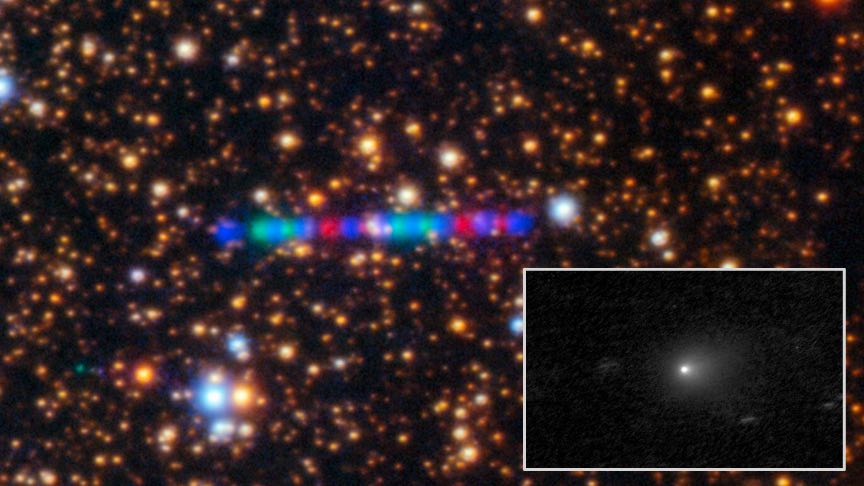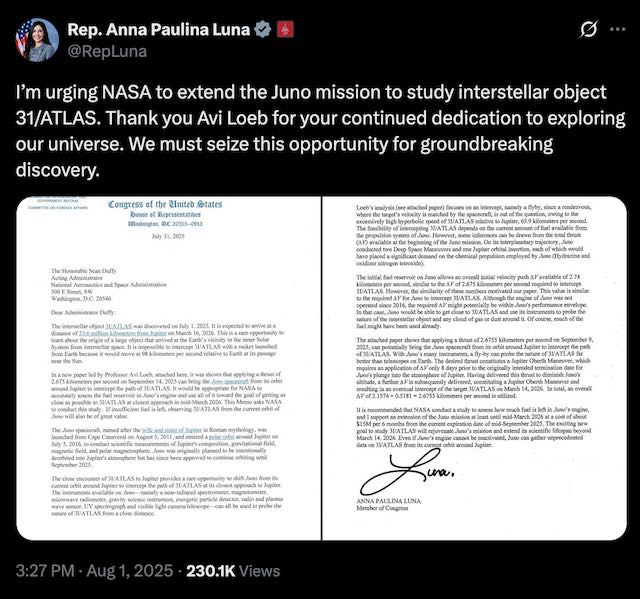Harvard astronomer Avi Loeb has been the most influential scientist to recognize the strange details about two of the three recent interstellar objects that have entered our solar neighborhood. His analysis of these objects first came to prominence as a result of his work on Oumuamua, the smaller interstellar object that was the first ever confirmed interstellar object to pass through the solar system.
Oumuamua was relatively small, perhaps maxing out at 3,000 feet in length. The object was first detected on October 19, 2017. It is on its way back out of the solar system, having passed Neptune in 2022. But certain of its characteristics were unusual, if not outright peculiar, not the least of which was that it managed to accelerate as it moved away from the sun, something astronomers call "non-gravitational accelerations." There have been several attempts to come up with a natural explanation for this observed phenomenon, but so far none have been satisfactory.
In a post on Medium, Loeb summed up the problem with natural explanations for the acceleration.
"The observed push of `Oumumua was about 0.1% of `Oumuamua’s speed. This implies that a third of all the available hydrogen in the water iceberg must evaporate in order to give `Oumuamua the observed kick of 0.1% of its speed," he wrote.

He continued: "Given that `Oumuamua was the size of a football field, it is unclear how a third of its total hydrogen mass can escape from a depth of tens of meters to its surface without pushing out water molecules along the way. Indeed, familiar comets show water vapor with dust. `Oumuamua cannot be a typical comet because it did not look like a typical comet."
Moreover, as Loeb further noted, Oumuamua had other anomalies as well. Writing in 2023, he concluded: "If the next `Oumuamua appears artificial, then we might feel like home owners who identified all objects in their back yard as rocks, including those tennis balls which originated from the cosmic street and were thrown by our neighbors."
Two years later, we now have another intriguing interstellar "tennis ball" in 3I/ATLAS.
3I/ATLAS Anomalies
As Loeb has readily admitted in his works, the simplest explanation of these interstellar objects is that they are natural. But, he notes that just as with Oumuamua there are intriguing anomalies with 3I/ATLAS -- and they are somewhat more disturbing.

- 3I/Atlas is enormous compared to Oumuamua. According to Loeb, it could be as much as 12 miles in diameter.
- Instead of a cometary tail - as might expected of a comet closing in on the sun, 3I/ATLAS is behaving differently. Loeb notes: "Another interesting fact gleaned from images of 3I/ATLAS is that it has a leading glowing halo rather than a trailing tail. Why is there a glow ahead of 3I/ATLAS?"
- 3I/ATLAS has a rare and unusual trajectory. Loeb: It's path "around the Sun lies within 5 degrees of that of Earth — the so-called ecliptic plane. The likelihood for that coincidence out of all random orientations is 0.2%."
- It will pass very close to Venus, Mars and Jupiter, an extraordinary coincidence with extremely low probability.
- It's coming at us from the center of Milky Way, a direction from which that made detection extremely difficult due, according to Loeb, to "crowding by background stars."
- This one is wild, but if it is not a natural object but is under some kind of control, Loeb notes that its trajectory makes it possible for it perform a "clandestine maneuver" when it is out of sight behind the sun that could, according to Loeb, allow "an optimal intercept of Earth" that would result in "an arrival late November or early December 2025."
A New Mission for the Juno Spacecraft
In recent days Avi Loeb has floated the idea of using the Juno Spacecraft, currently orbiting Jupiter, to investigate 3I/ATLAS. The new interstellar object is moving too fast for an intercept by a probe launched from Earth, but if Juno has enough fuel left, it could get into position for its onboard instruments to gather important data about the new interstellar object.
On July 31, Rep. Anna Paulina Luna sent a letter Sean Duffy, the acting head of NASA, asking for the space agency to begin an analysis of the fuel onboard Juno with an eye toward sending the probe to investigate the new interstellar object.
Juno is due to be decommissioned in September and crashed into Jupiter. That would be wasteful end to an expensive spacecraft that could be used for additional research on 3I/ATLAS.
In her letter to Duffy, Rep. Luna argued: "The close encounter of 3I/ATLAS to Jupiter provides a rare opportunity to shift Juno from its current orbit around Jupiter to intercept the path of 3I/ATLAS at is closest approach to Jupiter."
She also noted that the onboard instruments on Juno would be able to make useful measurements and observations.
"The instruments available on Juno -- namely a near-infrared spectrometer, magnetometer, microwave radiometer, gravity science instrument, energetic particle detector, radio and plasma wave sensor, UV spectrograph and visible light camera/telescope -- can all be used to probe the nature of 3I/ATLAS from a close distance."
Luna concludes her letter with a request to NASA to determine if Juno has enough fuel remaining to maneuver toward 3I/ATLAS and to extend the spacecraft's mission until mid-March 2026 in order to investigate 3I/ATLAS.
Dropping Juno onto Jupiter when there is a useful alternative for this otherwise expensive and fully functional spacecraft seems wasteful, and the $15 million cost of continuing Juno's mission is a relative bargain in space exploration, especially considering the opportunity to investigate closely the third interstellar object -- and the biggest and and most unusual one -- ever to be detected in the solar system.
As Loeb notes, the possibility of using Juno for this mission is a "a once-in-a-lifetime opportunity for human-made technologies to come within a short distance from a large interstellar object. This could actually happen in 2026 rather than appear in a Hollywood science-fiction script such as Stanley Kubrick’s film “2001: A Space Odyssey.”
Image credit: International Gemini Observatory/NOIRLab/NSF/AURA/K. Meech (IfA/U. Hawaii)Image Processing: Jen Miller & Mahdi Zamani (NSF NOIRLab) - https://noirlab.edu/public/images/noirlab2522c/, CC BY 4.0, https://commons.wikimedia.org/w/index.php?curid=170111508
Inset image credit: By Processing by Nrco0e. Images taken by David Jewitt/NASA/ESA/Space Telescope Science Institute (STScI). - Own work; raw images sourced from https://archive.stsci.edu/proposal_search.php?id=17830&mission=hst, Public Domain, https://commons.wikimedia.org/w/index.php?curid=170479257




